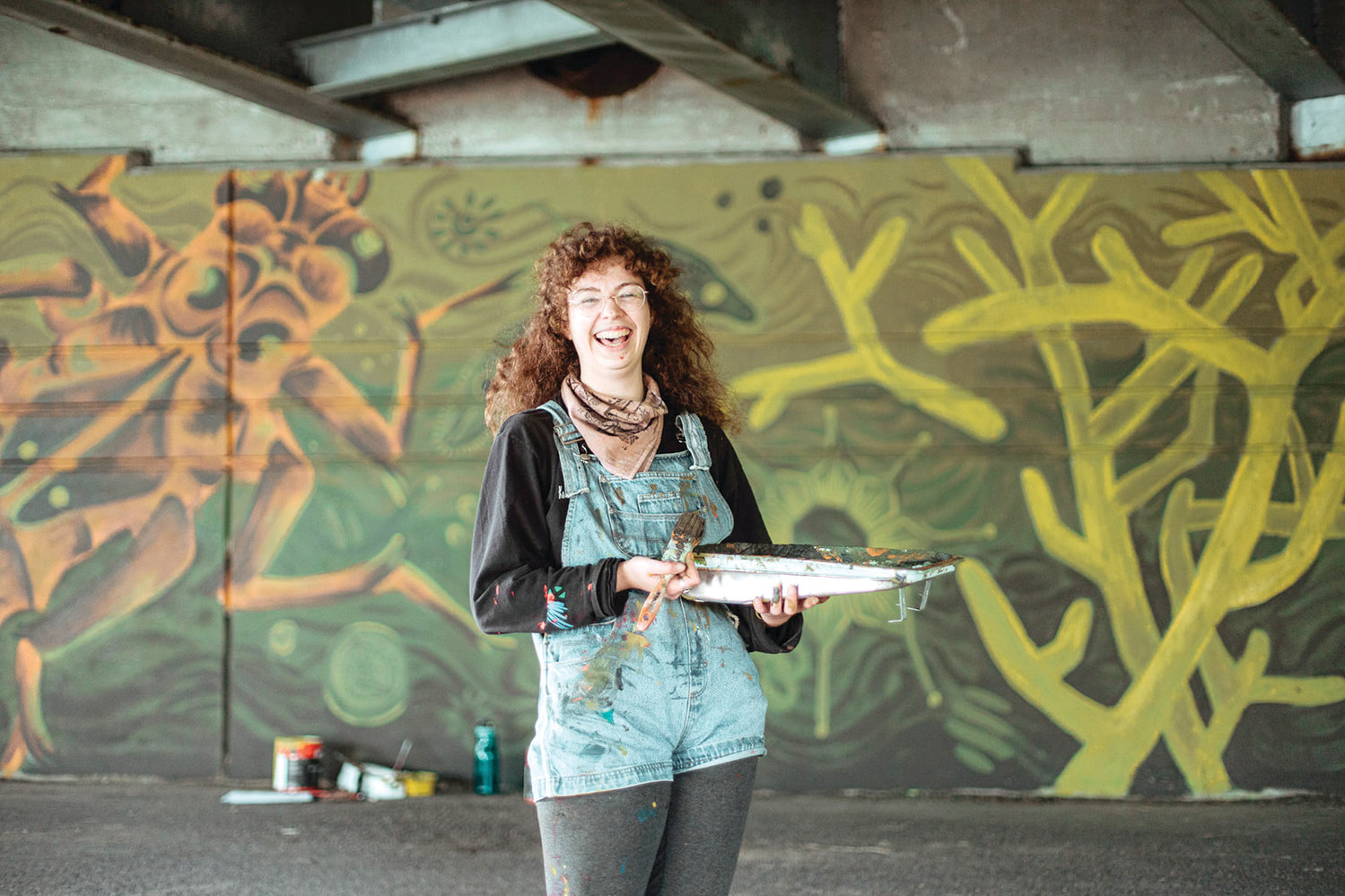
Lawrence Cosentino
Civilian and military authorities are advised that a pair of 12-foot-long dragonfly nymphs have been sighted under the Cedar Street Bridge along the Lansing River Trail. If these aquatic insects morph into dragonflies, their wingspan could reach 35 feet and they would be able to reach any target in Ingham County in minutes.
At ease, general. It’s just a painting.
But what a painting. “Pondscum,” an 80-foot-long mural by Grand Rapids artist Dayna Walton, is one of the high watermarks of Lansing Art Gallery’s 2020 ArtPath, an outdoor exhibit of 19 sculptures and paintings by Michigan artists.
Flanked by the biggest dragonfly nymphs ever to slither across the Earth, even in dinosaur days, Walton’s mural is filled out by vibrant strands of algae, geometrically exquisite diatoms, a hydra with an alarming plurality of appendages and a juicy daphnia with the interior parts visible through its membranous skin.
How much did Walton scale up these real yet utterly bizarre aquatic creatures?
“I wish I knew,” Walton said.
Some hasty math suggests that she blew the organisms up by 144X, at least. At such an absurd level of magnification, most of the color and detail work had to come from the artist’s imagination, but the effect is completely convincing.
A dragonfly spends most of its life as a nymph, feeding on the bottom of a river like the Red Cedar, which rolls lazily a few feet away from the mural.
“Aquatic insects are so crazy to me,” she said. “I have close encounters with a few weird ones every summer.”
Walton isn’t into cute nature images. She used murky, almost sickly green and brownish tones to evoke a “nice, crusty pond.”
“I like lichen and fungi and certain insects that other people might not think are cute,” she said. “If you look at the water microscopically, the geometry of the things you find is just so gorgeous. The idea is that if people see them in a form that’s not so cringe-y, maybe they’ll appreciate them more and not kill all the spiders in their house.”
Walton expected to paint a much smaller wall, now home to Stephanie Ellis’ “Rebirth,” a giant frog leaping over the Grand River on River Front Park. She packed “Pondscum” with two enormous dragonfly larvae and a greater variety of creatures than first planned.
“They were just like, ‘OK, here’s your bridge,’” she said. “It’s fine. I just tripled it, basically, and laid it out as I went along. I like working on the fly.”
The bridge leaves no buffer zone between the pathway and the wall, so it was a bit tricky for her to find a safe place to stand and work. Orange buckets on each side of the bridge warned pedestrians that something was going on.
“While I was painting, everybody was really friendly. A lot of people stopped to talk and say ‘thank you.’ Maybe it’s because they were cooped up for so long. It’s not always like that, painting in public.”
Walton is from Hudsonville, Michigan. She got her art degree from the Kendall College of Art and Design and still lives in Grand Rapids. She works at Lions and Rabbits gallery and teaches workshops there.
She grew up on a family farm surrounded by wild fields. Although there was very little water, she became an avid bird watcher and loved to look closely at insects and whatever else lived and grew beneath her feet.
She also does workshops at the Broad Art Museum’s Artlab, across Grand River from the museum building. The workshops mix printmaking and embroidery, using creating fabric designs that can be embroidered into images of extinct animals. (A virtual Zoom class is planned for September.) “I have one textile pattern that’s just a bunch of centipedes,” she said.
Her work is scattered around the Grand Rapids area. “Ancient Lake,” the back wall of Artisan Ales, is a green and gray fantasia of ancient seabed organisms such as trilobites.
After frustrating experiences in high school chemistry lab, science mixed with art pushed just the right button. Walton liked the chemistry of printmaking and tried out various materials, including limestone, while taking a lithography class in college.
“It’s simple, so much less intimidating than being in a real science lab,” she said. “You can learn by doing and use stuff you have around the house.”
She enjoyed a fellowship at the Pierce Cedar Creek nature preserve in Hastings, where art and science students collected data together. Last fall, she was an artist in residence at Smoky Mountain National Park, leading workshops with visitors and hanging out with a specialist in lichens, the hybrid algae-and-bacteria fur that paints mountain rocks and trees in limitless hues of red, orange, gray and green.
“The lichens like the altitude there, so they’re at their peak,” she said. “There’s this high point where the lichens cover everything. I’m still drawing out ideas I sketched from that trip.”
One idea is to paint a faux huge lichen on a brick building.
“It ties in with the microbes in ‘Pondscum,’” she said. “I like to find the patterns in things.”
"enter" - Google News
July 10, 2020 at 05:37AM
https://ift.tt/38GChxX
Enter the dragonfly: ArtPath mural 'Pondscum' magnifies aquatic life - City Pulse
"enter" - Google News
https://ift.tt/2TwxTMf
https://ift.tt/3d6LMHD
Bagikan Berita Ini














0 Response to "Enter the dragonfly: ArtPath mural 'Pondscum' magnifies aquatic life - City Pulse"
Post a Comment